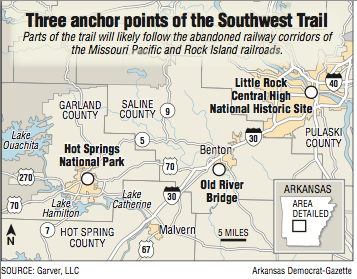Design of a bike trail that officials say will usher central Arkansas into a new era of outdoor tourism was awarded to a local engineering firm, area leaders said Wednesday.
Garver LLC, headquartered in North Little Rock with offices throughout the South, will complete the preliminary design of the Southwest Trail, a bike and walking path that will marry the Little Rock Central High National Historic Site with Hot Springs National Park.
The project is a partnership between Pulaski, Garland and Saline counties, though Pulaski County, alone, signed the contract with the firm.
The trail's total design cost, which includes the preliminary design cost, is estimated at $4 million, according to the contract, though that figure could change after an environmental assessment is finished.
"Every once in awhile a project comes across your desk you know is going to be a challenge," Pulaski County Judge Barry Hyde said at a news conference.
"And in that moment, even though you are staring at a colossal task -- and this has been kind of a colossal task -- you're so confident that the challenge is worthwhile that you push aside your reservations."
Though still a ways to go, Hyde said that once completed the trail will be on "every outdoor enthusiast's list of places to go and places they want to be."
Saline County Judge Jeff Arey added that the trail, which will span roughly 60 miles, will boost economic development and promote a healthier lifestyle among residents.
In January, Pulaski County issued a request for qualifications for architect and engineering services. Eight companies applied, and three of them presented to the county judges and staff members.
Garver was selected and will undertake the preliminary design, which is also referred to as a "65 percent" design. The company was involved in the Broadway Bridge replacement, among other high-profile projects.
What a 65 percent design means is that the plans will be "not quite finished but far beyond conceptual," said Wallace Smith, Garver's vice president and director of federal services. After completing an environmental assessment, which should take no more than 18 months, they'll know exactly where the trail will go, he said.
According to the contract, a maximum of $514,701 will be paid to Garver for conducting that assessment and for holding public involvement meetings. The county also agreed to reimburse the firm for certain costs it incurs.
Money to design the trail is largely coming from a $2.65 million federal lands access program grant, plus a 20 percent local match requirement to be paid by the three counties.
Pulaski and Saline counties also secured $260,000 each, plus another 20 percent local match, in federal transportation alternatives program money.
When and if the counties secure more money to fund a "100 percent" design, an amendment can be added to the contract for additional work, Smith said.
The trail will be anchored by three fixed points: Little Rock Central High National Historic Site, Hot Springs National Park and the Old River Bridge in Saline County.
How the trail should maneuver between those locations will be decided in the coming months.
Garver experts will examine the prevalence of wetlands, hazardous materials, endangered species and American Indian sites. They'll measure air and noise quality and find out if homes and businesses will need to be relocated.
Parts of the trail will likely go along abandoned Missouri Pacific and Rock Island railroad corridors, though the exact route is still an unknown, Smith said.
Garver also will host three public meetings, one in each county, so citizens can offer input.
Hyde spoke of the importance of community involvement. Friends of the Southwest Trail, a group in support of the multi-use path, has been "kind of standing at the starting line for two years at least while we got all this lined up," he said. Now, they'll have more active participation.
After the environmental assessment is completed, the land acquisition process can begin and, eventually, construction. That cost could be in the $35 million range, Smith said.
Metro on 04/12/2018

